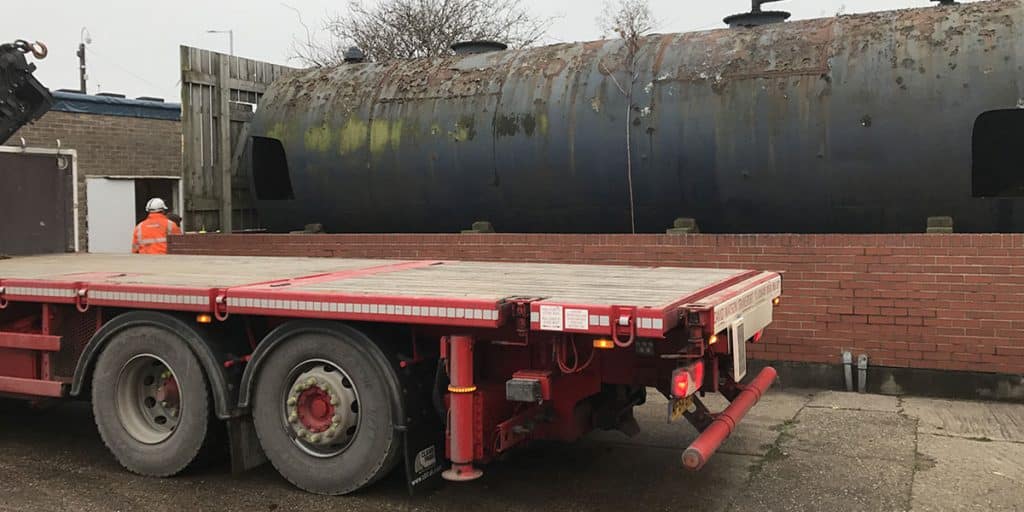Fuel and Oil Tank Decommissioning – A Guide
The object of this article is to give some information on the different types of fuel tank and oil tank decommissioning available, the methods used, and the reason for choosing that particular method. This guide can be utilised for both above and underground fuel and oil storage tanks. It must be recognised that any works on fuel and oil tanks should be carried out by a competent and experienced contractor. The contractor should adopt practices in line with guidance such as ‘Design, Construction, Modification, Maintenance and Decommissioning of Filling Stations (4th Edition), OFTEC Technical Book 3, HSE Guidance and Best Practice and all legal duties set out under the Health and Safety at Work Act 1974.
It is possible to separate the hazards presented by a fuel or oil tank, as this can impact on the required course of action when choosing to decommission your tank.
Fire and explosion risk – Ensuring tanks containing explosive atmospheres e.g. petrol tanks are not left in a potentially hazardous condition.
Environmental hazard – Ensuring that tanks are emptied of all residual liquid when no longer in use, to eliminate the possibility of a leak or spill.
Tank Removal
With any fuel or oil tank, the most effective method of decommissioning is to simply remove and dispose of the tank, as this is completely eliminating the hazard. Fuel and oil tank decommissioning by removal will generally begin by cleaning the tank internally, followed by either an uplift should the tank be external, cutting it into sections to remove it from a tank room, or excavation should the tank be underground.
By simply cleaning the tank internally, you are already eliminating the environmental hazard, as all liquid and sludge would be removed from the tank. All waste removed from any fuel or oil tank should be consigned as a hazardous waste, and a full audit trail created from the point of origin to disposal.
Even following an internal clean, tanks such as petrol can pose a danger. Over time, small pockets of product that can be held in welds may produce flammable vapours, causing the tank to ‘gas up’. A petrol tank should always be removed and opened up sufficiently to prevent vapour build up, or filled immediately following cleaning. A gas free certificate would always be issued for a petrol tank for a period not exceeding 24 hours, following which, additional atmospheric monitoring would be required.
An oil tank following cleaning
The cost of oil tank decommissioning or fuel tank removal tanks does vary. Underground tanks or large internal tanks are generally the most expensive tanks to remove, however variables such as grade of oil, size, location will all impact on this. Oils such as Heavy Fuel Oil are difficult to deal with, and also therefore result in a more expensive price.
Please also see our services page for information on different options for tank cleaning, tank removal and disposal.
Solid Filling Tanks with Foam or Concrete.
Should removal not be an option for any reason, petrol, diesel and heating oil tanks can all be filled with either a resin based foam or void filling concrete. In any situation, it is always recommended that the environmental hazard e.g. remaining liquid / tank bottoms are removed from a tank, thus ensuring that if the shell of the tank ever becomes compromised, no liquid can run from the tank into surrounding areas.
It is rare for an above ground tank to be filled in order to be decommissioned (unless petrol), it is largely promoted towards underground tanks. The main reason to decommission a redundant petrol tank is to eliminate any void in which vapour can accumulate. Resin foam and today’s modern void filling concrete will both achieve the desired result in filling a tank to the brim, thus preventing any such build up.
Structural stability can also be a reason to fill an underground fuel or oil tank, should removal not be an option. Once redundant, tanks can often be forgotten about, this can lead to a potential soft spot or collapse, should a tank fail structurally.
As for whether foam filling tanks is better than concrete filling, they both have their benefits. Concrete can certainly be a cheaper option for smaller tanks as there is no mobilisation fee for delivery. However, concrete is more expensive per cubic metre, which can result in the foam mobilisation fee being offset once a particular quantity is achieved. The overall cost to decommission a tank by solid fill depends on the capacity of the tank, as this will depict the quantity of product used. A benefit of foam filling tanks is certainly the ability to remove and dispose of the product should the tank be required again in the future.
Once again, any works on fuel and oil tanks should be carried out by a competent and experienced contractor.
A petrol tank being filled with resin foamTank Cleaning & Leaving In Situ
Again, when deciding on a method for fuel and oil tank decommissioning, certain tanks can be emptied, cleaned and simply left in situ. The method undertaken will depend on both the customer requirements and the construction of the tank. Diesel, kerosene and oil tanks with a suitable man lid can be cleaned, resealed and left ready for any potential re-use. Should a tank not have a lid, and not be required for any future use, a hole can be cut into the tank, the tank cleaned and left in situ until such time it requires removal. Providing the tank has been cleaned thoroughly, any smell coming from the tank should dissipate leaving a clean piece of steel in it’s place.
As mentioned previously, this does not apply to petrol tanks, due to the residual risk of vapours being released. However diesel, gas oil and kerosene tanks do not have the same level of volatility as petrol, thus enabling them to remain in situ with all product removed.
A shot of a tank cleaner at work.Temporary Fuel and Oil Tank Decommissioning
Occasionally a tank requires taking out of commission for a short period of time e.g. change in ownership. There are a number of options available, depending on the tank and it’s content.
Tanks with low hazard products such as diesel, gas oil and kerosene, can be simply emptied of residual product and left for a period of time. We always recommend emptying the tank as this reduces the risk of a spill should damage occur to the tank or pipework whilst the tank is not being monitored.
Tanks holding petrol do require making safe even if they are only being taken out of service for a short period of time. This can be achieved by emptying the tank of all product, and filling with water, thus eliminating the void in which vapours can build. Prior to any such work being carried out on a petrol tank, approval must be obtained from the local petroleum licensing officer.
J. W. Hinchliffe (Tanks) Ltd
As a company, J W Hinchliffe (Tanks) Ltd have specialised in fuel and oil tank decommissioning for nearly 50 years. Using our own in-house team, we can offer a bespoke service to meet the needs of any client, from transport operators, to the construction and public sectors. If you would like to know more about the services we offer, please see our services page. If you would like to contact us directly, you can email [email protected] or call directly on 01132635163 where you can speak immediately to an experienced tank decommissioning engineer.
All of our work is carried out in line with current best practice and legislation. You can read more industry news through organisations such as the APEA (Association for Petroleum & Explosives Administration) by clicking here.

